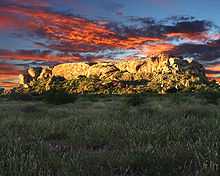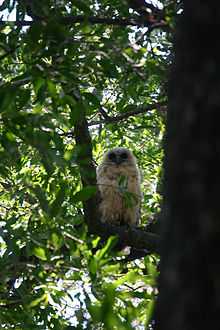Mapungubwe National Park
| Mapungubwe National Park | |
|---|---|
|
IUCN category II (national park) | |
 Mapungubwe Hill | |
 | |
| Location | Limpopo, South Africa |
| Nearest city | Musina |
| Coordinates | 22°15′S 29°12′E / 22.250°S 29.200°ECoordinates: 22°15′S 29°12′E / 22.250°S 29.200°E |
| Area | 280 square kilometres (110 sq mi) |
| Established | 1995 |
| Governing body | South African National Parks |
| World Heritage Site | 2003 |
| Official website | |
Mapungubwe National Park is a national park in Limpopo Province, South Africa. It is located by the Kolope River, south of the confluence of the Limpopo and Shashe rivers and about 15 km to the NE of the Venetia Diamond Mine. It abuts on the border with Botswana and Zimbabwe, and forms part of the Greater Mapungubwe Transfrontier Conservation Area. It was established in 1995[1] and covers an area of over 28 000 hectares. The park protects the historical site of Mapungubwe Hill, which was the capital of the Kingdom of Mapungubwe, as well as the wildlife and riverine forests along the Limpopo River. The Mapungubwe Hill was the site of a community dating back to the Iron Age. Evidences have shown that it was a prosperous community. Archaeologists also uncovered the famous golden rhino figurine from the site.[2] It is one of the few places in Africa that has both Meerkats and Nile crocodiles.[citation needed]
Mapungubwe National Park is renowned for its scenic landscape. Unique sandstone formations, woodlands, riverine forest and baobab trees combine to give it a fascinating look.[2]
Wildlife
The park supports numerous animals and bird species. Beside the usual residents like the elephant, giraffe, white rhino, lions, leopards and hyenas, there are numerous antelope species in the park. A total of 400 species of birds have been recorded from the park, including Pel's Fishing Owl, Kori bustard, and Tropical Boubou.[2]
The status of the park as part of the Transfrontier Conservation Area is severely threatened by the planned exploitation of coal reserves in the immediate vicinity of the reserve. An open-cast coal mine and power plant are planned in the buffer zone of the National Park, which threaten its Natural and Cultural values.[3] In addition, the large amount of water required for the mining activities will impact the ecology of a large part of the region.[4]


See also
References
- ↑ "Mapungubwe National Park and World Heritage Site: History of the Park". SANParks. Retrieved 7 July 2009.
- ↑ 2.0 2.1 2.2 "Mapungubwe National Park". South African National Parks. Retrieved 16 March 2013.
- ↑ Mining threatens Mapungubwe
- ↑ South Africa: Sanparks Opposes Proposal to Mine Coal at Mapungubwe
External links
- Mapungubwe National Park
- Effect of Small Catchment Dams on Downstream Vegetation of a Seasonal River in semi-arid African Savanna